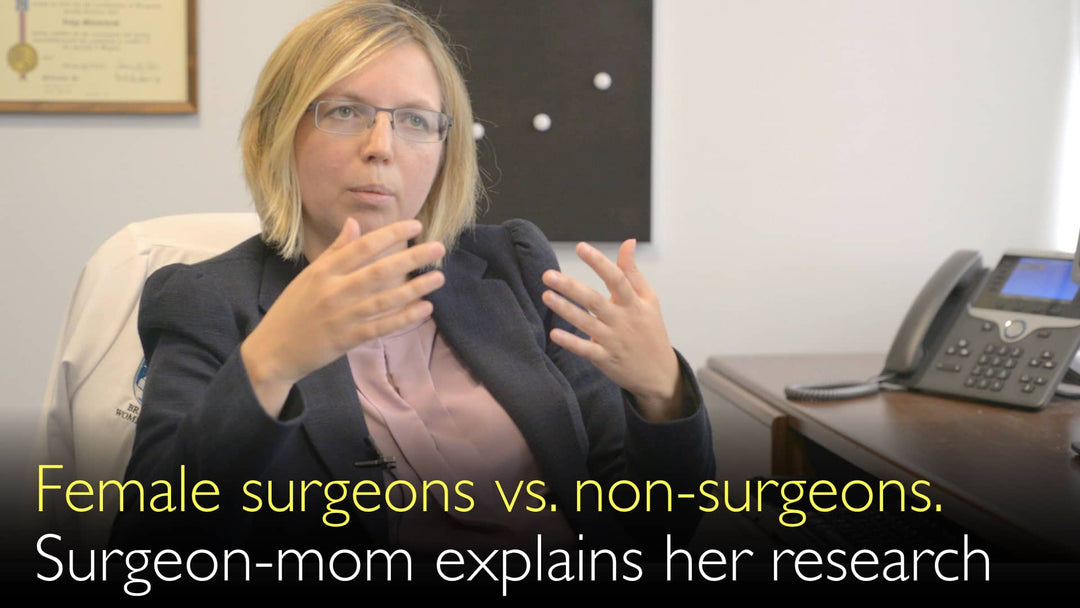מומחית מובילה בהכשרה כירורגית ואיזון עבודה-חיים, ד"ר נליה מלניצ'וק, MD, מסבירה את האתגרים הייחודיים העומדים בפני מנתחות. מחקרה חושף חופשות לידה קצרות יותר ונשיאה בנטל כלכלי גבוה יותר עבור נשים בתחומים פרוצדורליים. ד"ר מלניצ'וק, MD, דנה בסיפוק מקצועי ובהשפעת ההכשרה הארוכה על תכנון משפחה. היא מציעה עצות קריטיות לרופאות צעירות השוקלות קריירה כירורגית ואימהות גם יחד.
אתגרים ופתרונות למנתחות: חופשת לידה ושביעות רצון מקצועית
קפיצה לפרק
- ממצאי מחקר על מנתחות
- השפעת ציר זמן ההכשרה הכירורגית
- שביעות רצון מקצועית בתחומים פרוצדורליים
- ייעוץ לרופאות צעירות
- חופשת לידה בארצות הברית
- לחצים מערכתיים ופתרונות
- תמליל מלא
ממצאי מחקר על מנתחות
ד"ר נליה מלניצ'וק, רופאה ומנתחת ואם, ערכה מחקר שהונע על ידי ניסיון אישי. מחקריה מתמקדים בהשפעת ההכשרה הרפואית על איכות החיים ותוצאות ההיריון. המחקר השווה בין רופאות בתחומים פרוצדורליים ולא פרוצדורליים.
ממצאים מרכזיים מראים שנשים בכירורגיה, גינקולוגיה וגסטרואנטרולוגיה לוקחות חופשת לידה קצרה יותר. הן גם חובות יותר כסף למרפאות שלהן עם חזרתן לעבודה. ד"ר מלניצ'וק מציינת שנשים אלה מדווחות על שביעות רצון מקצועית נמוכה יותר. הן מביעות רצון רב יותר לשנות את התמחותן בהשוואה לעמיתותיהן בתפקידים לא פרוצדורליים.
השפעת ציר זמן ההכשרה הכירורגית
ציר הזמן הארוך של ההכשרה הכירורגית בארצות הברית יוצר לחץ משמעותי. ד"ר אנטון טיטוב וד"ר מלניצ'וק דנים במסלול הסטנדרטי. לאחר בית הספר לרפואה, ההתמחות נמשכת חמש עד שבע שנים. לאחר מכן часто עוברים להתמחות על (fellowship) להמשך התמחות.
הכשרה מורחבת זו意味着 רופאים часто מסיימים בגיל שלושים ומשהו. תקופה זו חופפת לירידה טבעית בפוריות. מחקרה של ד"ר מלניצ'וק לא אישר שימוש גבוה יותר בשירותי הפריה חוץ-גופית (IVF) среди מנתחות. היא משערת שזה עשוי להיות потому שהמחקר סקר נשים שכבר ילדו successfully ילדים.
שביעות רצון מקצועית בתחומים פרוצדורליים
אי-שביעות רצון מקצועית היא בעיה מרכזית עבור מנתחות. השילוב של קריירה בלחץ גבוה ומשפחה צעירה הוא מאתגר intensely. מחקרה של ד"ר מלניצ'וק סקר both מתמחות ורופאות מומחיות.
היא מצאה שהבעיות היו עקביות בשתי הקבוצות. הלחץ של איזון between חובות קליניות וחיי משפחה מוביל לשחיקה. זהו גורם קריטי בכך שנשים בתחומים פרוצדורליות עשויות לשקול מחדש את מסלול הקריירה שלהן.
ייעוץ לרופאות צעירות
ד"ר נליה מלניצ'וק מציעה ייעוץ ישיר based על ממצאיה. המלצתה העיקרית היא לא לדחות לידת ילדים אם זה אחד מיעדי החיים. היא מכירה בכך שהיריון during התמחות הוא קשה.
However, ד"ר נליה מלניצ'וק, מדגישה שזה also מאתגר כרופאה מומחית. אין זמן מושלם. היא מייעצת לרופאות צעירות לזהות את סדרי העדיפויות האישיים שלהן ואז לרדוף after them בנחישות.
חופשת לידה בארצות הברית
מדיניות חופשת הלידה בארה"ב אינה עקבית и часто לא מספקת.对于 מתמחות רפואיות, החופשה היא typically שישה עד שמונה שבועות. האורך יכול depend on whether הלידה была בניתוח קיסרי.
רופאות מומחיות may be זכאיות to עד 12 שבועות חופשה under חוק חופשת המשפחה והרפואה (FMLA). פגם קריטי is that FMLA does not מחייב חופשה בתשלום. whether החופשה is בתשלום depends entirely on המעסיק הספציפי וההסדר הקליני.
לחצים מערכתיים ופתרונות
לחצים מערכתיים often מאלצים מנתחות לקחת פחות חופשת לידה. כיסוי החולים של מנתחת מטיל עומס on השותפים. זה יוצר תחובת חובה מקצועית לחזור לעבודה quickly.
There is also עומס כספי משמעותי on מערכת הבריאות. ד"ר מלניצ'וק conclude that ארצות הברית must לפתח שיטה טובה יותר. מערכת המספקת חופשת לידה בתשלום לכולם is essential for תמיכה במנתחות אימהות ובמשפחותיהן.
תמליל מלא
ד"ר אנטון טיטוב: את חוקרת how הכשרה רפואית וכירורגית משפיעה על איכות חיים, תוצאות היריון, ושביעות רצון מקצועית among רופאות. פרסמת several מחקרים מעניינים מאוד on נושא זה. what גילית במחקרך on רופאות?
ד"ר נליה מלניצ'וק: כן, זה actually פרויקט that was of עניין אישי עבורי because אני מנתחת ואם. יש לי שני ילדים. עשינו several תגליות מעניינות.
נשים בתחומים פרוצדורליים לוקחות חופשת לידה קצרה יותר. נשים חובות יותר כסף למרפאות שלהן when הן must לחזור לעבודה. התמחויות רפואיות פרוצדורליות הן כירורגיה, גינקולוגיה, וגסטרואנטרולוגיה.
נשים have פחות שביעות רצון מקצועית. הן would like לשנות את התמחותן much more frequently than רופאות בתחומים לא פרוצדורליים. סיבה אחת is probably also הטיית בחירה, because סקרנו נשים that are early in גיל גידול הילדים.
כל הילדים שלהן young, עד חמש or שש שנים. הן in the trenches of העבודה הקלינית. הן obviously must להתמודד with הקריירה המקצועית שלהן. At the same time, רופאות must להתמודד with המשפחה שלהן. It is more difficult לשלב קריירה כירורגית ומשפחה.
ד"ר אנטון טיטוב: בואי נסביר את החינוך הרפואי בארצות הברית for הצופים הבינלאומיים שלנו. After רופאות צעירות בארצות הברית מסיימות בית ספר לרפואה, הן usually עוברות חמש שנים of תוכנית ההתמחות. תוכנית ההתמחות takes חמש שנים, especially בתחומים פרוצדורליים. הן עובדות כרופאות, but that is עומס נוסף on אדם. Then הן become רופאות מומחיות, like את now.
סקרת רופאות mostly during תוכנית ההתמחות or התמחות על? Or were הן already רופאות מומחיות?
ד"ר נליה מלניצ'וק: We actually סקרנו both מתמחות ורופאות מומחיות. סקרנו רופאות that were in training ורופאות that already were done with ההכשרה. There was no huge difference in אורך חופשת הלידה or issues that שתי הקבוצות מתמודדות איתן.
It is true, in ארצות הברית ההכשרה הכירורגית very long. אנשים לומדים רפואה and then הם עושים התמחות for about חמש to שבע שנים. Then הם עושים התמחות על נוספת. When אתה done with all ההכשרה, אתה in your mid-thirties. That is הגיל where הפוריות starts לרדת.
We did look at that. We studied whether רופאות used more שירותי הפריה חוץ-גופית (IVF). We studied whether רופאות בתחומים פרוצדורליים had problems להרות. We did not confirm that theory, but it might be because we surveyed all הנשים that already had kids. So הן were successful in השגת היריון.
ד"ר אנטון טיטוב: עשית and פרסמת research on שביעות רצון מקצועית ואתגרים of מנתחות. what ייעוץ would you give to רופאות צעירות? Maybe הן מסיימות בית ספר לרפואה or only starting ההתמחות? what should הן do?
ד"ר נליה מלניצ'ок: אל תדחי לידת ילדים if זה אחד מיעדיך בחיים. Because החיים unpredictable and אתה never know what can happen. להיות בהריון during התמחות will be difficult. But להיות בהריון and having children is also difficult when את רופאה מומחית.
Just figure out what is important for you. Then achieve היעד שלך.
ד"ר אנטון טיטוב: what is חופשת לידה typical בארצות הברית, if there is one?
ד"ר נליה מלניצ'וק: חופשת לידה for רופאות varies. It depends. For מתמחות it's שישה to שמונה שבועות. אורך חופשת הלידה also depends if was לידה בניתוח קיסרי or not. When את רופאה מומחית, את can לקחת up to 12 שבועות. But some חופשת לידה is בתשלום, some of it is unpaid. It depends on what מצב העבודה הקלינית שלך.
בארה"ב we follow חוק FMLA. חוק זה basically tells the מעסיקים that they must לתת 12 שבועות חופש to אדם that just had baby. But it does not מחייב חופשה בתשלום. המציאות of המצב difficult.
There is a lot of pressure לקחת פחות זמן for חופשת לידה in סביבת העבודה הקלינית בלחץ גבוה. Definitely. Because, first of all, רופאה אחרת must לטפל בחולים שלך. There is an increased burden on השותפים שלך potentially, although אתה try to לשלם להם back if הן חולות or if somebody else takes חופשת לידה.
There is also a financial burden on מערכת. Here in ארצות הברית we really must to figure out השיטה הטובה יותר to לספק חופשת לידה בתשלום to all האימהות.





